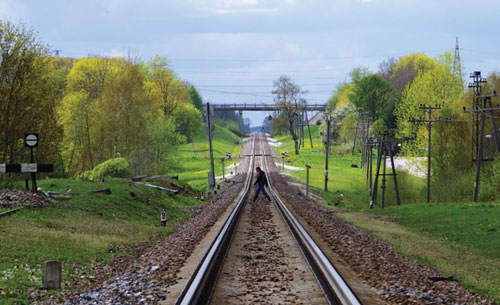Upholding high safety levels on the Estonian railway network
Posted: 7 April 2015 | | No comments yet
The Technical Regulatory Authority in Estonia is an agency working under the Ministry of Economic Affairs and Communications with a broader objective to help implement national economic policies through the improvement of safety, organising sensible use of limited resources and increasing the reliability of products in the fields of manufacturing environments, industrial equipment, railways, and electronic communication. In the field of railways, the Technical Regulatory Authority acts as the National Safety Authority (NSA) for Estonia in-line with European Union legislation. The NSAs responsibilities have been divided between two departments: the Railway Transport Department and the Railway Infrastructure Department. Heigo Saare, Head of the Railway Infrastructure Department, provides further information and explains the key activities of the Authority…


The main goal of the NSA is to improve, through our main activities (supervision, safety authorisation, authorisation for placing into service), the safety level of the Estonian railway network. The Railway Transport Department mainly issues railway safety certificates, safety authorisations, railway vehicle authorisations and exercises state supervision to inspect compliance with the requirements set for the possessors of railway vehicles, dangerous goods, and railway traffic management.
The Railway Infrastructure Department mainly issues building permits and permits for the use of railway civil engineering works and grants written consent for the demolition of station sidings, depot sidings, platforms, and for the reconstruction of railway superstructure. We approve activities within a railway protection zone; approve of the detailed plans and design criteria which constitute the basis for building design documentation of railway civil engineering works, and exercise state supervision over performance of construction work on railways.
Supervision of railway safety
State safety monitoring (including the monitoring of the application of the safety management system) is performed at three different levels in the structure of the undertaking: the strategic level, the intermediate level, and the tactical level:
Strategic level
Assessment of the application of the SMS at the strategic level (by the management of the enterprise):
- The measures taken to achieve the safety policy and objectives instituted by the enterprise, and the effectiveness thereof
- Intra-organisational division of responsibility, education, training, and documentation and circulation of safety information
- Assessment and analysis of the results of the internal audit of the enterprise
- Assessment of the quality and circulation of legal information
- Inspection and assessment of the enterprise’s risk assessment procedure and plan for action in the event of an accident
- Assessment of the need for supplementing the SMS.
Intermediate level
Assessment of processes at the intermediate level (by the heads of structural units of the enterprise):
- Monitoring of worker competence and the implementation of training courses
- Assessment of the legality of the processes and their effect on third parties
- Monitoring of the circulation and documentation of information
- The implementation of the enterprise’s safety policy and objectives on all levels of the organisation.
Tactical level
Assessment of activities and processes at the tactical level (stations, depots, trains):
- Monitoring of the professional competence of workers
- Assessment of the legality of activities
- Monitoring of the documentation of activities and information (the existence of an audit trail)
- Assessment of the relevance of the measures applied in order to achieve the safety policy and objectives of the enterprise.
In principle, the supervision activities related to monitoring the application of the safety management system of a railway undertaking are based on the common safety methods established by the European Commission.
Placing into service railway subsystems
Technical Specifications for Interoperability (TSIs) have been revised and their scope has extended to 1,520mm networks. Due to the fact that implementing EU norms in the Baltic States while authorising railway subsystem has not been well known so far, the new legal framework will reflect 1,520mm networks even more seriously. Nevertheless, the Technical Regulatory Authority has proved how to put into practice appropriate EU standards and norms, for example authorisations for new passenger fleets and locomotives. In the field of railway superstructure, TSIs for infrastructure have not been practically used and so far national legislation and rules have applied. The following paragraph explains in more detail the procedure for placing into service railway subsystems in Estonia.
The procedure for building permits and permits for use of railway civil engineering works is closely linked to the undertaking, local government and the Technical Regulatory Authority. Building design documentation of railway civil engineering works is based on a detailed plan or design criteria which must be approved by the Technical Regulatory Authority. Therefore, the first step for an undertaking is to approach the local government to ensure that a plan is adopted or design criteria are issued. The adopted plan or design criteria must be approved by the Technical Regulatory Authority.
When approving the documents, the Technical Regulatory Authority monitors that the design criteria allows for the construction of the required civil engineering works, that the normative documents are relevant, and that no unreasonable requirements are established. If everything is in order, the Technical Regulatory Authority approves the design criteria or the plan. Otherwise, the design criteria or the plan is approved with additional conditions indicating the shortcomings/weaknesses that must be addressed during the design process.
The next step is applying for a building permit. In connection with this process, it will be necessary to provide the Technical Regulatory Authority with a building permit application and the building design documentation. As part of the process of issuing a building permit, the Technical Regulatory Authority will check whether the activities which the licence is being applied for (erection, expansion, reconstruction or demolition) are reflected in the application. An application for a building permit can only be submitted by the owner of the civil engineering works or the land unit. In addition, the Technical Regulatory Authority will check whether the persons specified in the application are competent for the purposes and whether material information concerning the civil engineering works has been provided.
In the case of the building design documentation, the Technical Regulatory Authority will verify that the required approvals have been acquired and that the documentation corresponds to the design criteria or the detailed plan. In addition, the Technical Regulatory Authority will ascertain whether it will be possible to build the civil engineering works in question based on the submitted building design documentation. For this purpose, the explanatory memorandum and the graphic part of the documentation must demonstrate the compliance of the civil engineering works with the relevant normative documents and national technical rules.
During the construction of railway civil engineering works, the Technical Regulatory Authority will selectively exercise state supervision by checking the competence of the builder and the person exercising owner supervision, the compliance of the construction of the civil engineering works with the design documentation, and the compliance of the materials in use with the relevant requirements, etc. Compliance with the safety requirements for the building period will also be monitored.
The last step is applying for a permit for use. This involves submitting an application to the Technical Regulatory Authority for the permit for use and the technical construction documentation. The Technical Regulatory Authority shall check the records of construction work and the reports on covered works and shall, on the basis thereof, assess the execution of the work and its compliance with the building design documentation. Through this process, the Technical Regulatory Authority shall also check the compliance of the subsystem (civil engineering works) with the established requirements. Certificates of conformity of used materials are important for the purpose of verifying the compliance of construction products with the requirements. User manuals must also be submitted to the Technical Regulatory Authority.
As the last step, the Technical Regulatory Authority will organise a review committee for the civil engineering works, involving the necessary participants. If the civil engineering works are in compliance with the requirements, the Technical Regulatory Authority will issue the permit for use.
Safe integration
The safe integration process (creating legal prerequisites, technical inspection and procedure for placing into service new subsystems) of the new passenger rolling stock to the Estonian railway network, initiated in 2010, and was one of the main activities of the Technical Regulatory Authority in recent years, which ended recently in two significant parts.
Firstly, the Technical Regulatory Authority considered the tests with Stadler Flirt multiple units successful and the documentation submitted for evaluation with the trains compliant with the requirements valid in the European Union and Estonia. The Authority placed into service the Stadler Flirt multiple units on the Estonian railway networks.
Secondly, compatibility between passenger waiting platforms and new trains was created in the entire Estonian railway network. Reconstructing the waiting platforms to the height of 550mm was finished in 2014.
Improving railway safety
One of the activities concerning railway safety is prevention. In Estonia, the Technical Regulatory Authority and the NGO Operation Lifesaver Estonia, are organising railway safety campaigns. The objective of the campaign is to direct people’s attention towards the changes due to the new trains introduced on the routes and to call everyone to follow traffic rules and safety instructions upon crossing the railway, entering and exiting the train, plus moving around in the railway area.
The message of the last campaign was related to the new passenger fleet (http://ole.ee/rong/en/). As the new trains are faster, quieter, and of different appearance, the habitual traffic environment has changed for train commuters, pedestrians and car drivers crossing the railway, as well as people moving around near the railway. Therefore, it is necessary to be even more attentive in regards to safety. The maximum speeds did not change with the new trains, but the road users still need to consider that the new trains accelerate much more quickly when pulling away and crossing the railway directly in front of a train is more dangerous than ever. One should also consider that the new trains make significantly less noise, so spotting the approaching train may be more difficult. In addition, the train timetable will become more intense and therefore it is necessary to be especially attentive around crossings and on waiting platforms.
Biography
Heigo Saare started as a Chief Specialist in the NSA Estonia Railway Transport Department in 2011 where his biggest challenge was the authorisation of a new passenger fleet. In 2013, he continued as the Head of the Railway Infrastructure Department. Heigo graduated from the TTK University of Applied Sciences with a Railway-Engineering diploma. Now he nears the end of his Master Studies in Transport Planning at Tallinn University of Technology where he has focused his thesis on railway level crossings safety in Estonia.






